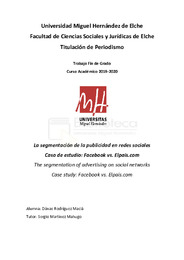Por favor, use este identificador para citar o enlazar este ítem:
https://hdl.handle.net/11000/27252Registro completo de metadatos
| Campo DC | Valor | Lengua/Idioma |
|---|---|---|
| dc.contributor.advisor | Martínez Mahugo, Sergio | - |
| dc.contributor.author | Rodríguez Maciá, Dánae | - |
| dc.contributor.other | Departamentos de la UMH::Ciencias Sociales y Humanas | es_ES |
| dc.date.accessioned | 2022-05-20T10:40:45Z | - |
| dc.date.available | 2022-05-20T10:40:45Z | - |
| dc.date.created | 2020-07-13 | - |
| dc.identifier.uri | http://hdl.handle.net/11000/27252 | - |
| dc.description.abstract | Periodismo y publicidad son dos disciplinas que siempre han estado ligadas porque cada una complementa a la otra. La publicidad ha necesitado siempre de un soporte de difusión que fuera aceptado por los consumidores; y las editoriales y productoras necesitaban ingresos por esta vía para sobrevivir. Hoy en día, las redes sociales son uno de los principales canales de difusión de los medios tradicionales y también una de las principales plataformas publicitarias. En este trabajo se presenta un estudio sobre la efectividad de la publicidad en las redes sociales. Recorreremos brevemente la historia de las redes sociales, su evolución y nos centraremos en la red social Facebook y las posibilidades de segmentación y comercialización que nos ofrece, para posteriormente compararla con el diario de prensa digital El País, valorando especialmente su eficacia y capacidad de control. No entraré a valorar la calidad de los mensajes, por su contenido y su diseño gráfico, aunque sin duda estos atributos podrían modificar sutilmente la eficacia de la publicidad y consecuentemente la certeza absoluta del estudio; pero aun así nos aportara una idea bastante aproximada de su efectividad. El trabajo de campo se ha llevado a cabo a través del método cuantitativo para interpretar los datos de un cuadro comparativo de creación propia sobre las posibilidades actuales de segmentación de la publicidad online. Dicho cuadro se aplica por un lado al objeto de estudio de este trabajo: las redes sociales. Y por otro lado al objeto con el que lo comparamos: la publicidad en los medios convencionales, y en este caso en concreto elpais.com que se utiliza como caso de estudio. En líneas generales, los resultados obtenidos indican que la creciente inversión publicitaria por parte de las empresas aumenta la efectividad de la publicidad en las principales redes sociales. | es_ES |
| dc.description.abstract | Journalism and advertising are two disciplines that have always been linked because each complements the other. Advertising has always needed a broadcast medium that was accepted by consumers; and publishers and producers needed income this way to survive. Today, social media is one of the main channels of dissemination of traditional media and also one of the main advertising platforms. This work presents a study on the effectiveness of advertising on social networks. We will briefly review the history of social networks, their evolution and we will focus on the social network Facebook and the possibilities of segmentation and marketing it offers us, to later compare it with the digital press newspaper El País, especially evaluating its effectiveness and control capacity . I will not go into evaluating the quality of the messages, due to their content and graphic design, although these attributes undoubtedly could subtly modify the effectiveness of advertising and, consequently, the absolute certainty of the study; But even so, it will give us a fairly approximate idea of its effectiveness. The field work has been carried out through the quantitative method to interpret the data from a comparative table of own creation on the current possibilities of segmentation of online advertising. This table is applied on the one hand to the object of study of this work: social networks. And on the other hand, the object with which we compare it: advertising in conventional media, and in this case specifically elpais.com, which is used as a case study. In general terms, the results obtained indicate that the increasing advertising investment by companies increases the effectiveness of advertising on the main social networks. | es_ES |
| dc.format | application/pdf | es_ES |
| dc.format.extent | 50 | es_ES |
| dc.language.iso | spa | es_ES |
| dc.publisher | Universidad Miguel Hernández de Elche | es_ES |
| dc.rights | info:eu-repo/semantics/openAccess | es_ES |
| dc.rights.uri | http://creativecommons.org/licenses/by-nc-nd/4.0/ | * |
| dc.subject | periodismo | es_ES |
| dc.subject | redes sociales | es_ES |
| dc.subject | nuevas tecnologías | es_ES |
| dc.subject | jóvenes | es_ES |
| dc.subject | segmentación | es_ES |
| dc.subject | prensa digital | es_ES |
| dc.subject | journalism | es_ES |
| dc.subject | social networks | es_ES |
| dc.subject | new technologies | es_ES |
| dc.subject | youth | es_ES |
| dc.subject | segmentation | es_ES |
| dc.subject | digital press | es_ES |
| dc.subject.other | CDU::0 - Generalidades.::070 - Periódicos. Prensa. Periodismo. Ciencias de la información | es_ES |
| dc.title | La segmentación de la publicidad en redes sociales. Caso de estudio: Facebook vs. Elpais.com | es_ES |
| dc.title.alternative | The segmentation of advertising on social networks. Case study: Facebook vs. Elpais.com | es_ES |
| dc.type | info:eu-repo/semantics/bachelorThesis | es_ES |

Ver/Abrir:
TFG-Rodríguez Maciá, Dánae.pdf
1,52 MB
Adobe PDF
Compartir:
 La licencia se describe como: Atribución-NonComercial-NoDerivada 4.0 Internacional.
La licencia se describe como: Atribución-NonComercial-NoDerivada 4.0 Internacional.
.png)